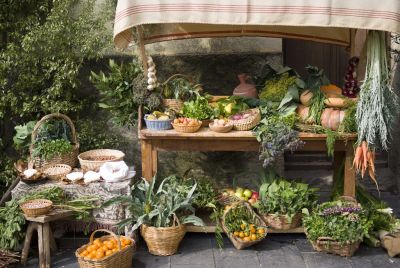Italy is renowned for its rich culinary traditions, which are deeply connected to the land and its seasonal bounty. Italians place great importance on fresh, local ingredients, making seasonal produce a cornerstone of their diet. Eating seasonally ensures optimal flavor, nutritional value, and sustainability. Let’s explore Italy’s seasonal produce, highlighting the best fruits and vegetables available throughout the year.
Spring (Primavera): Spring in Italy brings a fresh wave of delicate, vibrant flavors. As the weather warms, markets overflow with tender greens and colorful produce.
Asparagus is a prized delicacy in Italy, often enjoyed in risottos, frittatas, or simply grilled with olive oil. Artichokes (carciofi) are particularly abundant in Rome, where they are prepared alla giudia (Jewish-style, deep-fried) or alla romana (braised with herbs). Fava Beans (fave) are commonly eaten raw with pecorino cheese, a classic Roman springtime snack. Peas (piselli) are sweet, tender, and ideal for soups, pasta dishes, and side dishes. Strawberries (fragole) are a seasonal favorite, perfect for desserts, jams, and fresh salads and although citrus fruits (agrumi) are primarily a winter crop, late-season oranges and lemons remain widely available.
Summer (Estate): Summer in Italy is a paradise for fruit lovers, with an abundance of juicy, sun-ripened delights. Vegetables thrive under the Mediterranean sun, adding bold flavors to Italian cuisine.
Tomatoes (pomodori) are the heart of Italian cooking used in sauces, salads, and bruschetta. Zucchini (zucchine) are frequently stuffed, grilled, or turned into delicate zucchini flowers (fiori di zucca), which are fried to perfection. Eggplants (melanzane) are essential for dishes like parmigiana di melanzane, a layered eggplant, tomato, and cheese casserole. Peppers (peperoni) are ideal for roasting, stuffing, or incorporating into Mediterranean dishes. Melons (meloni) like sweet cantaloupe and watermelon are refreshing treats on hot summer days and cherries (ciliegie) are a beloved seasonal fruit often eaten fresh or used in desserts like crostata di ciliegie. Figs (fichi), available in late summer, are enjoyed fresh, dried, or paired with prosciutto.
Autumn (Autunno): As temperatures cool, Italy’s produce shifts toward heartier, earthier flavors. Autumn is also the season for Italy’s prized truffles and mushrooms.
Mushrooms (funghi) – Porcini and other wild mushrooms flourish, featuring in risottos, pastas, and sauces. Pumpkin (zucca) is a staple in northern Italian cuisine, used in creamy risottos and stuffed pasta like ravioli di zucca. Roasted chestnuts (castagne) are a popular street food in autumn. Everyone knows grapes (uva) are harvested for winemaking, but grapes are also enjoyed fresh or in schiacciata con l’uva, a Tuscan grape focaccia. The jewel-like seeds of Pomegranates (melagrana) add bursts of flavor to salads and desserts. Persimmons (cachi) are a sweet, custard-like fruit often eaten fresh.
Winter (Inverno): Winter brings hearty, nutrient-rich produce that forms the backbone of comforting Italian meals.
Citrus Fruits (agrumi) like Oranges, lemons, mandarins, and blood oranges provide a vitamin C boost and brighten winter dishes. Cabbages (cavoli) including savoy cabbage and Tuscan kale (cavolo nero) are essential for soups like ribollita. Radicchio is a bitter, deep red leafy vegetable used in salads, grilled dishes, and risottos. Broccoli and cauliflower (broccoli e cavolfiore) are versatile vegetables enjoyed steamed, roasted, or in pasta dishes. Leeks (porri) are a flavorful addition to soups and stews. Pears (pere) are a winter fruit that pairs beautifully with cheeses and desserts.
Choosing seasonal produce not only enhances the taste and nutritional value of food but also supports local farmers and reduces the environmental impact of long-distance transportation. Italy’s culinary traditions thrive on fresh, high-quality ingredients, making each season a delicious celebration of nature’s bounty.
Next time you visit Italy or your local Italian market, embrace the rhythm of the seasons and savor the best that nature has to offer!



